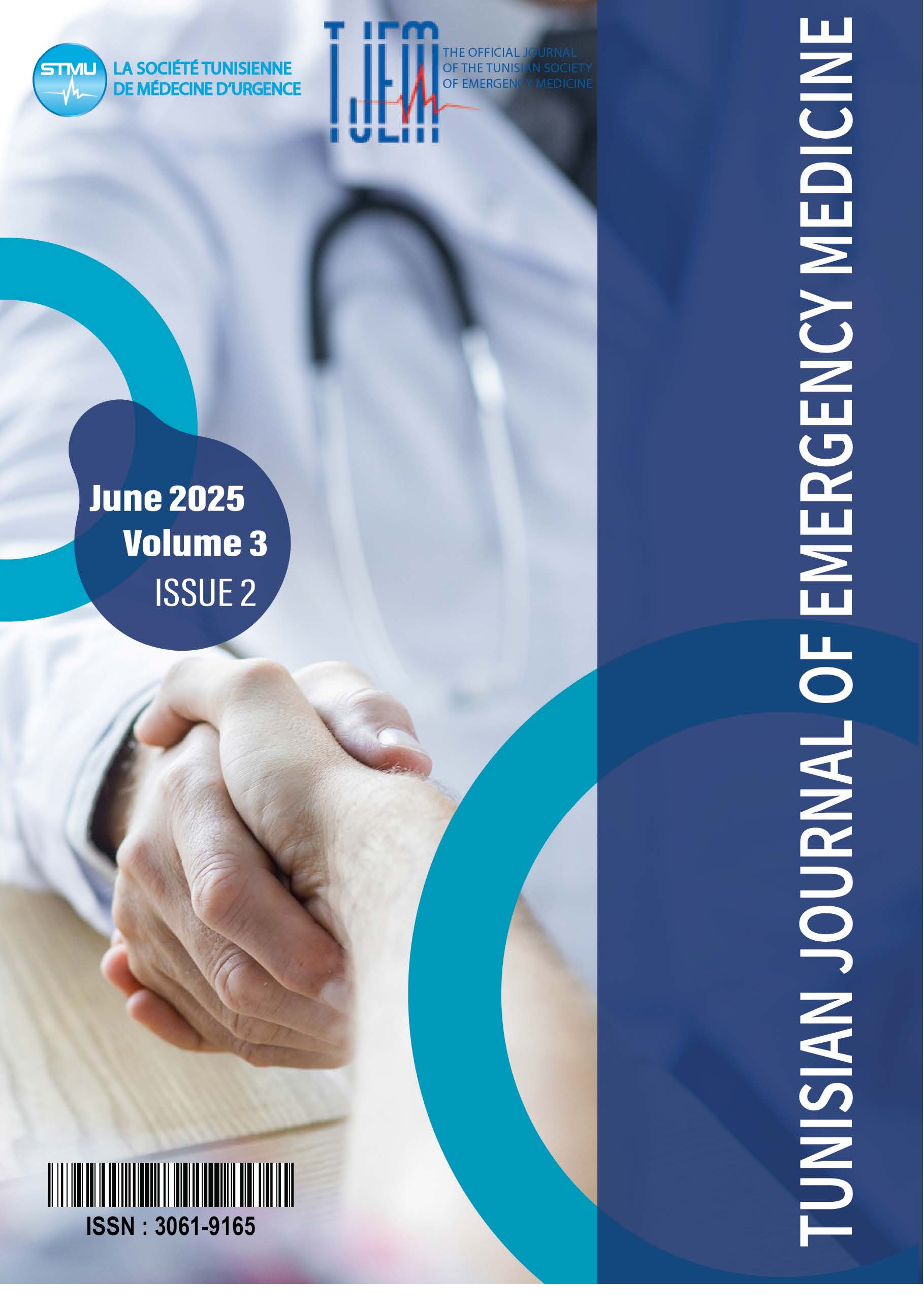Mortality in Pediatric Intensive Care
DOI:
https://doi.org/10.0000/a7e1bc19Keywords:
child mortality, intinsive care units, pediatrics, risk factors, retrospective studiesAbstract
Abstract:
Background: Mortality in pediatric intensive care units is a major concern in critical care medicine due to the unique physiological and clinical characteristics of children. Understanding the causes and complications associated with mortality is essential to improve patient outcomes.
Aim: This study aims to analyze the mortality profile in a pediatric intensive care unit by identifying the main causes of death and associated complications. The objective is to better understand the contributing factors to mortality in order to improve clinical management and care strategies.
Methods: We conducted a retrospective descriptive study including all patients who died in the pediatric intensive care unit at Hedi Chaker University Hospital in Sfax over a one-year period, from September 2023 to September 2024. Demographic data, clinical characteristics, underlying conditions, treatments received, and complications were collected and analyzed.
Results: A total of 41 deaths were recorded during the study period, corresponding to a mortality rate of 14.08%. The highest mortality was observed in spring (21.8%) and summer (18.18%). The median age of deceased patients was 15.4 months, ranging from 7 days to 11 years, with a male predominance (65.9%). Most children lived in urban areas (75.6%), and 46.3% came from socioeconomically disadvantaged backgrounds. Underlying conditions were present in 26.8% of patients, and 36.6% were born to consanguineous parents. More than half (51.2%) were referred from pediatric wards. Mechanical ventilation was used in 90.2% of cases, and vasoactive drugs in 70.7%. The most common complications were cardiovascular (68.3%), metabolic (56%), hematological (56%), respiratory (46.3%), infectious (43.9%), and neurological (26.8%). Infectious causes were the leading cause of death (26.82%), including severe acute bronchiolitis (14.63%) and malignant pertussis (22%). Congenital heart diseases accounted for 7.31% of deaths.
Conclusions: This study highlights the principal causes and complications associated with pediatric mortality in intensive care. These findings provide important insights for improving risk stratification, optimizing care strategies, and ultimately reducing mortality in critically ill children.
Downloads
Published
Issue
Section
License
Copyright (c) 2025 Tunisian Journal of Emergency Medicine

This work is licensed under a Creative Commons Attribution-NonCommercial-ShareAlike 4.0 International License.
How to Cite
Similar Articles
- Samia Meherzi, Rihab Omri, Amin khbou , Rabiaa Kaddechi , Afifa CHARFI, Management of Bell palsy: our clinical practice guideline , Tunisian Journal of Emergency Medicine: Vol. 3 No. 1 (2025): TJEM 2025: Vol.3 Issue 1
- Dr.Rania AMMAR ZAYANI, Dr.Sarra Temani, Dr. Mabrouk Bahloul, Dr.Chokri Ben Hamida, Pregabalin Toxicity-Induced Posterior Reversible Encephalopathy Syndrome , Tunisian Journal of Emergency Medicine: Vol. 3 No. 2 (2025): TJEM 2025: Vol.3 Issue 2
- Faten DHOUIB, Aimen Dammak, Faiza Safi, Fatma MHIRI, zied CHAARI, Successful Conservative Management of Penetrating Cervical Tracheal Injury: A Case Report , Tunisian Journal of Emergency Medicine: Vol. 3 No. 1 (2025): TJEM 2025: Vol.3 Issue 1
- Wiem Feki, Fatma Hammami, Amina Kammoun, Makram Koubaa, Mounir Ben Jemaa, Zaineb Mnif, Emphysematous pyelonephritis with infected abdominal aorta pseudoaneurysm among a diabetic man , Tunisian Journal of Emergency Medicine: Vol. 3 No. 2 (2025): TJEM 2025: Vol.3 Issue 2
- Neila MAAROUFI, Youssef Zouaghi, Khaoula Amdouni, Sabra Ouaz, Beligh Oueslati, Moufida Nouari, Beyond the Rash: The Fatal Consequences of Lyell Syndrome , Tunisian Journal of Emergency Medicine: Vol. 3 No. 2 (2025): TJEM 2025: Vol.3 Issue 2
- Fatma MHIRI, Aimen Dammak, Faiza Safi, Oumaima KHARDENI , Faten DHOUIB, Olfa chakroun-walha, Diagnostic Challenges and Treatment Strategies in Axillary Trauma: A Case Report , Tunisian Journal of Emergency Medicine: Vol. 2 No. 4 (2024): TJEM Vol2 Issue4
- Marwa TOUMIA, Fatma Zaouali, Lamia Bouzgarrou, Guillain–Barré syndrome after an asymptomatic COVID‐19 Infection: a case report , Tunisian Journal of Emergency Medicine: Vol. 3 No. 1 (2025): TJEM 2025: Vol.3 Issue 1
- Dorra Loghmari , Epidemiological and prognostic factors associated with road traffic accidents occurring in the Center East of Tunisia. , Tunisian Journal of Emergency Medicine: Vol. 2 No. 3 (2023): TJEM Vol2 Issue3
- Asma ZORGATI, Short and long-term outcomes of patients presenting with Acute Coronary Syndrome without ST-segment elevation (NSTE -ACS): findings from a Tunisian Register: the ReSCUS Register , Tunisian Journal of Emergency Medicine: Vol. 2 No. 2 (2022): TJEM Vol2 Issue2
- R. Obame, Serious abdominal traumatic emergencies in the emergency department of a “Trauma Center” hospital of Libreville (Gabon): Epidemiological, diagnosis and outcomes aspects , Tunisian Journal of Emergency Medicine: Vol. 2 No. 3 (2023): TJEM Vol2 Issue3
You may also start an advanced similarity search for this article.
Most read articles by the same author(s)
- Rania Hammami, Syrine Triki, Aimen Dammak, Faiza Safi, Olfa Chakroun , An abrupt cardiogenic shock in a female at the era of COVID 19 pandemic lockdown , Tunisian Journal of Emergency Medicine: Vol. 3 No. 1 (2025): TJEM 2025: Vol.3 Issue 1
- Faten DHOUIB, Aimen Dammak, Faiza Safi, Fatma MHIRI, zied CHAARI, Successful Conservative Management of Penetrating Cervical Tracheal Injury: A Case Report , Tunisian Journal of Emergency Medicine: Vol. 3 No. 1 (2025): TJEM 2025: Vol.3 Issue 1
- Faiza Safi, Traditional Medicine with Cade Oil in Pediatric Emergency Care , Tunisian Journal of Emergency Medicine: Vol. 2 No. 4 (2024): TJEM Vol2 Issue4
- Fatma MHIRI, Aimen Dammak, Faiza Safi, Oumaima KHARDENI , Faten DHOUIB, Olfa chakroun-walha, Diagnostic Challenges and Treatment Strategies in Axillary Trauma: A Case Report , Tunisian Journal of Emergency Medicine: Vol. 2 No. 4 (2024): TJEM Vol2 Issue4

